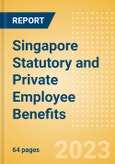The Republic of Singapore’s social security system is founded on principles of self-provision and self-reliance, and the government limits expenditure on social security schemes. Government policy has been that each generation must earn and save enough for their entire life cycle, with each individual responsible for their financial sustenance after retirement. The Central Provident Fund (CPF) is a key component of the Singaporean social security system. Most mandatory and state-sponsored benefits are limited to nationals and permanent citizens.
Key Highlights
- Ministry of Manpower, Ministry of Social and Family Development, the Ministry of Health, and the Central Provident Fund (CPF) Board are responsible for the functioning of the overall social security system
- A person’s national insurance contribution is determined based on their income
- An insured person who is unemployed or unable to work and whose benefits have been exhausted is entitled to a credited contribution
- In Singapore, employers provide voluntary retirement benefits to their employees through Supplementary Retirement Scheme, Section 5 scheme, Offshore Plans and Unfunded arrangement
Scope
This report provides a detailed analysis of employee benefits in Singapore:
- It offers a detailed analysis of the key government-sponsored employee benefits, along with private benefits
- It covers an exhaustive list of employee benefits, including retirement benefits, death in service, long-term disability benefits, medical benefits, workmen's compensation insurance, maternity and paternity benefits, family benefits, unemployment, long-term care benefits, minimum resources, leaves and holidays, and private benefits
- It highlights the economic and regulatory situations relating to employee benefits in Singapore
Reasons to Buy
- Make strategic decisions using in-depth information related to employee benefits in the country
- Assess employee benefits of the market, including state and compulsory benefits and private benefits
- Gain insights into the key employee benefit schemes offered by private employers in the country
- Gain insights into key organizations governing employee benefits market, and their impact on companies








